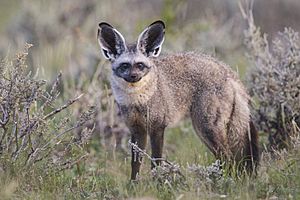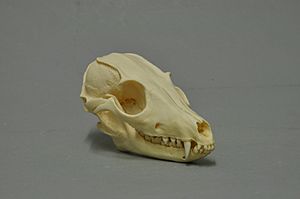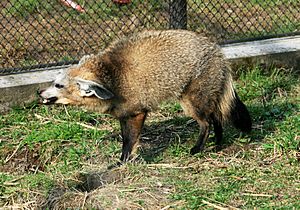Bat-eared fox facts for kids
Quick facts for kids Bat-eared fox |
|
|---|---|
 |
|
| Conservation status | |
| Scientific classification | |
| Genus: |
Otocyon
|
| Species: |
megalotis
|
| Subspecies | |
|
|
 |
|
| Bat-eared fox range | |
| Synonyms | |
|
|
The bat-eared fox (Otocyon megalotis) is a unique type of fox that lives in the African savanna. It gets its name from its super-sized ears, which are used to help it stay cool. Some people even call it Africa's version of the fennec fox because of its huge ears!
Contents
What Does a Bat-Eared Fox Look Like?
The bat-eared fox is also known by other names like Delalande's fox or big-eared fox. It has fur that is a light brown or tan color. Its ears, legs, and parts of its pointed face are black.
These foxes are about 55 centimetres (22 in) long from their head to their body. Their amazing ears can be as long as 13 centimetres (5.1 in)!
Where Do Bat-Eared Foxes Live?
Bat-eared foxes live in two separate areas of Africa. One group, called O. m. virgatus, lives in places like Ethiopia, southern Sudan, and Tanzania.
The other group, O. m. megalotis, lives in southern Africa. You can find them from southern Zambia and Angola all the way to South Africa. They also live in Mozambique and Zimbabwe. Each fox family usually has a home area that can be from 0.3 to 3.5 square kilometers in size.
What Kind of Home Do They Like?
Bat-eared foxes love to live in short grasslands. They also enjoy the drier parts of the savanna. They prefer open ground and areas where the grass is kept short by animals like ungulates (hoofed animals) that eat grass.
They mostly hunt in these short grass areas. However, if they feel threatened, they will go into taller grasses or thick bushes to hide. Besides raising their young in dens, these foxes use dens they dig themselves. These dens protect them from very hot or windy weather. In South Africa, they also rest under acacia trees to find shade during the day.
What Do Bat-Eared Foxes Eat?
The bat-eared fox mainly eats insects. It uses its large ears to find its prey. About 80–90% of their diet is a type of termite called harvester termites.
When these specific termites are not around, they eat other kinds of termites. They also eat other small creatures like ants, beetles, crickets, grasshoppers, millipedes, moths, and scorpions. Sometimes, they might even eat small birds, mammals, reptiles, or even some types of fungi. The insects they eat give them most of the water they need.
How Do They Find Food?
Bat-eared foxes often hunt in groups, usually in pairs or threes. Sometimes, after family groups split up, individual foxes will hunt alone. They find their food mostly by listening, not by smelling or seeing.
During winter, they usually hunt during the day. They often hunt in specific spots where their prey, like termite colonies, are found. Because they are social and don't fight over food, groups can hunt together in these areas.
How Do Bat-Eared Foxes Behave?
In some northern areas, like Serengeti, these foxes are active at night most of the time. But in South Africa, they are active at night in the summer and during the day in the winter.
Bat-eared foxes are very social animals. They often live in pairs or groups of up to 15 foxes. The home areas of these groups can overlap a lot or very little. Foxes in a group will hunt, play, and rest together. This helps them stay safe from animals that might try to hunt them. They also groom each other throughout the year.
How Do Bat-Eared Foxes Have Babies?
Female bat-eared foxes are pregnant for about 60–70 days. They usually give birth to one to six baby foxes, called kits. After the mother stops feeding the kits milk (which lasts about 14 to 15 weeks), the father takes over.
The male fox grooms, defends, keeps the young warm, watches over them, and even carries them between different den sites. The female fox goes out to find food. This food helps her make enough milk for the pups, who really depend on it.
In the Kalahari region, pups are born between September and November. In the Botswana region, they are born between October and December. Young bat-eared foxes leave their family groups when they are about 5–6 months old. They can have their own babies when they are 8–9 months old.
What Threats Do They Face?
Bat-eared foxes are helpful to humans because they control the population of harvester termites, which can be pests. People in Botswana have also hunted them for their fur. Other dangers to bat-eared fox populations include diseases and droughts, which can reduce the number of insects they eat. However, there are no major threats to bat-eared fox populations right now.
Images for kids
See also
 In Spanish: Zorro orejudo para niños
In Spanish: Zorro orejudo para niños







